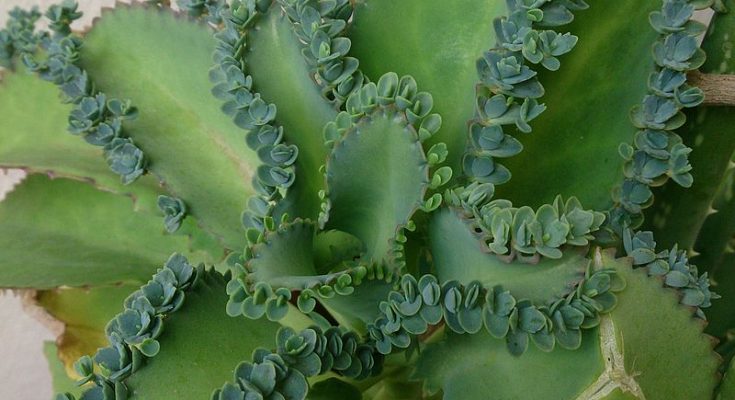Table of Contents
Reproduction in Plants
Reproduction is the biological process by which new plants are produced, ensuring the survival and spread of a species. Plants have developed various reproduction modes, each with unique methods and benefits, allowing them to thrive across different environments.
The Two Paths of Plant Reproduction
- Sexual Reproduction
- Asexual Reproduction
Sexual Reproduction- The Seed-Bearing Process
- The Role of Flowers- Flowers are the reproductive structures in plants. They facilitate the process of sexual reproduction, which results in the production of seeds.
- Pollination and Fertilisation- Pollen from male parts of a flower (or from another flower) fertilises the female ovule. This union forms seeds, which will grow into new plants.
- Genetic Diversity- Through sexual reproduction, plants combine genetic material from two parents, creating variations in the offspring. This diversity is vital for the adaptability and evolution of plant species.
- Seed Dispersal- Once formed, seeds disperse through mechanisms such as wind, water, or animals, allowing the plant species to colonize new areas.
Asexual Reproduction- The Seedless Process
- Direct Growth- In asexual reproduction, plants produce new individuals without seeds or flowers, using other plant parts like stems, roots, or leaves.
- Rapid Propagation- This method allows for the quick and widespread creation of new plants, identical to the parent, ensuring rapid expansion of the species.
Also Check – Rapid Revision – Class 7 Science- Chapter 12 – Reproduction in Plants
Vegetative Reproduction – Nature’s Cloning
What is Vegetative Propagation?
- Definition- A form of asexual reproduction where plants grow new individuals from vegetative parts – that is, non-flower parts of the plant.
- The Mechanisms Involved-
- Roots- Some plants can sprout new individuals directly from their roots.
- Stems- Certain plants use stems to grow new plants. For example, runners in strawberry plants stretch out and take root, forming new plants.
- Leaves– Leaves can also be a source for new plant growth. In plants like Bryophyllum, new plants can sprout from the edges of a leaf.
Also Check – Vegetative Propagation- A Detailed Exploration for Young Learners
Buds- The Starters of New Growth
- Location and Function- Buds are found in the axils of leaves (the angle between the leaf and stem) and are the beginnings of new growth.
- Types of Buds-
- Flower Buds- Develop into flowers which then participate in sexual reproduction.
- Vegetative Buds- Grow into new stems and leaves and can sometimes become entirely new plants through vegetative propagation.
Flowers and Fruits- Central to sexual reproduction, resulting in seeds that carry forward the plant’s genetic lineage.
Asexual Reproduction- A rapid method that clones the parent plant, bypassing the need for seed formation.
Vegetative Propagation- A unique form of asexual reproduction, using the vegetative parts of the plant to produce new individuals.
Section- Activity Vegetative Propagation through Cuttings and Buds
Objective of Activity
- To understand and observe the process of vegetative propagation through cuttings and buds.
Activity Details and Observations
Using Cuttings
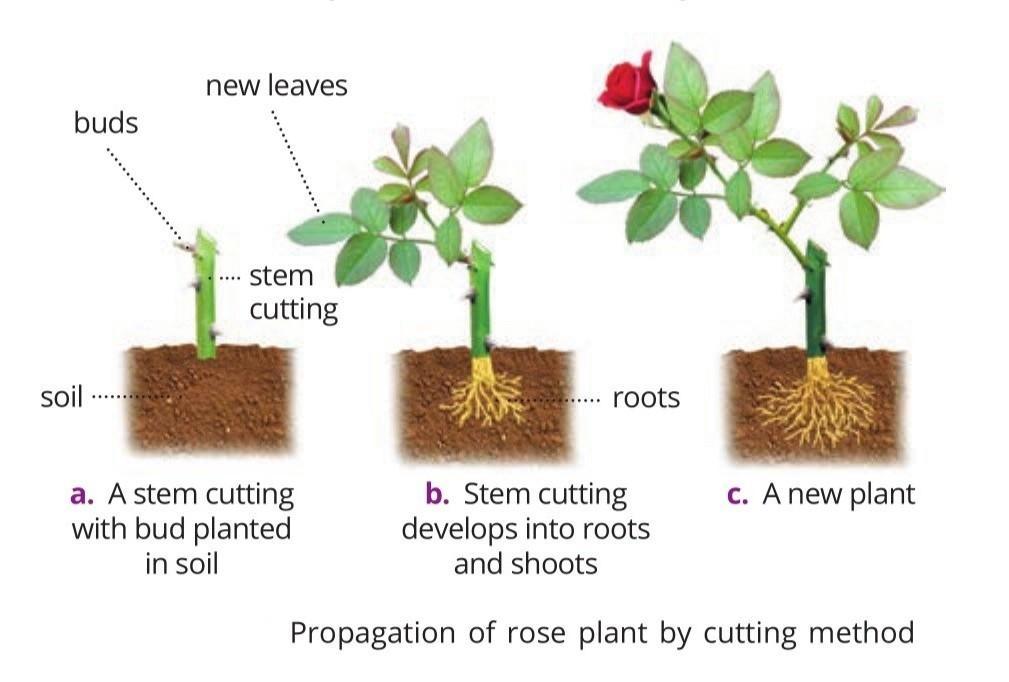
- Procedure- A branch (cutting) with a node from a rose or champa is planted in soil.
- Node- Part where a leaf arises on the stem/branch.
- Observations Required-
- Monitor and record the number of days taken for roots to develop and new leaves to emerge.
- Ensure regular watering to observe optimal growth.
Using Buds
- Procedure- Observation of vegetative buds in the axil of leaves that develop into shoots.
- Vegetative Buds- Located at the point where the leaf attaches to the node.
- Structure of Buds- Comprises a short stem with immature, overlapping leaves.
- Potential of Buds- Capable of giving rise to new plants.
Comparative Activity- Money Plant
- Procedure- Try growing a money plant in water and observing its progression.
- Objective- To compare the growth process in water against growth in soil.
Key Concepts to Note for Revision
- Cuttings-
- Sections of plants (branch/stem) that can be planted to give rise to new plants.
- Nodes play a critical role as the points where new leaves and stems arise.
- Vegetative Buds-
- Special structures that can develop into new shoots or plants.
- Located at specific points on the stem/branch, usually where leaves attach.
- Practical Application-
- Conducting these activities provides practical insights into vegetative propagation.
- It enhances understanding of the growth process from cuttings and buds.
Section- Activity – Vegetative Propagation through Various Plant Parts
Objective of Activity
- To explore and comprehend the role of different plant parts in vegetative propagation.
Activity Details and Observations
- Using Potato Eyes
- Procedure-
- Observe potato scars (eyes) using a magnifying glass.
- Cut the potato into pieces, each containing an eye, and plant them in soil.
- Observations-
- Monitor and record growth progression over several days with regular watering.
- Procedure-
- Using Other Plant Parts
- Procedure and Observations-
- Similar activities can be performed using ginger or turmeric.
- Notable in plants like Bryophyllum, where buds on leaf margins can give rise to new plants.
- Some roots, like those of sweet potatoes and dahlias, can also sprout new plants.
- Procedure and Observations-
- Detached Plant Parts
- Example- Cacti can reproduce from parts that become detached from the main plant body.
Methods in Vegetative Propagation

Vegetative propagation, a form of asexual reproduction, exhibits diversity in methods across different plant species. Here are some methods-
- Eyes of the Potato- Potatoes have “eyes” (small scars), which are essentially buds. When these portions of the potato are planted, they can give rise to entirely new potato plants.
- Rhizomes- Underground stems like those found in ginger and turmeric can grow into new plants when planted.
- Leaf Buds- Some plants, such as the Bryophyllum, have buds located on the margins of their leaves. When these leaves fall onto moist soil, the buds can sprout into new plants.
- Roots- In some plants, the roots themselves can give rise to new plants. Examples include sweet potato and dahlia.
- Detached Body Parts- Certain plants like cacti can reproduce when parts of them are detached from the main plant. These detached parts, when in the right conditions, can grow into new individual plants.
Also Check – NCERT Solutions for Class 7 Science Chapter 12-Reproduction in Plants
Advantages of Vegetative Propagation
- Rapid Multiplication- This method allows for faster production of plants as compared to the seed-based approach.
- Uniformity- Since the new plants are genetically identical to the parent, there’s a consistency in traits, which is beneficial for commercial crops requiring specific characteristics.
- Maturity- Plants produced through vegetative propagation reach maturity quicker, bearing flowers and fruits sooner than those grown from seeds.
- No Need for Pollination- Plants that may have difficulty with seed production due to absent or ineffective pollination can still reproduce.
- Preservation of Hybrid Characteristics- Hybrids that may not produce seeds or whose seeds might not retain hybrid characteristics can be propagated vegetatively to maintain the desired traits.
Importance of Different Plant Parts in Propagation
- Stems- They can store nutrients and provide support for the plant. In propagation, they can develop roots and eventually a whole new plant, e.g., potato eyes or rhizomes in ginger.
- Leaves– Besides photosynthesis, some leaves play a direct role in reproduction. In plants like Bryophyllum, the buds on leaf margins can grow into new plants.
- Roots- While primarily for anchorage and nutrient absorption, in some plants, they play a role in asexual reproduction. Plants like sweet potato and dahlia can sprout new plants from their roots.
- Buds- These are condensed shoots that can give rise to new plants. Depending on their location (axillary or terminal) and function (flowering or vegetative), they can develop into flowers or shoots.
Yeast and Budding
What is Yeast
- Yeast is a single-celled fungus, too small to see with the naked eye, but with a massive impact in the worlds of baking and brewing.
Budding in Yeast
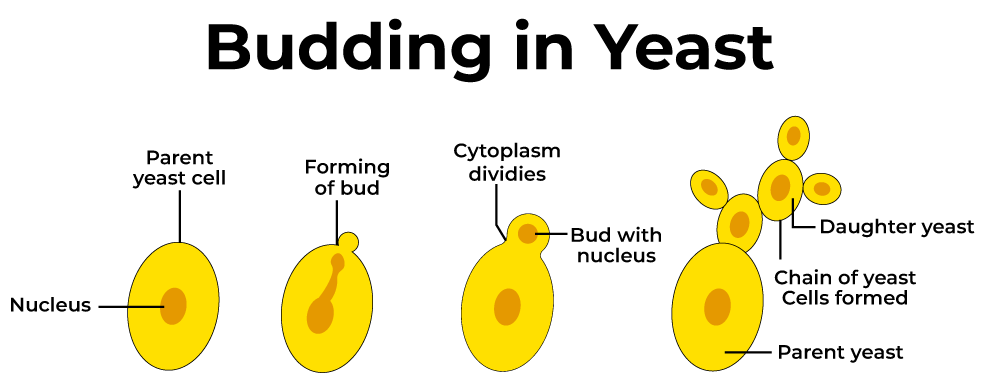
- Budding is a form of asexual reproduction where a new, identical yeast cell grows from the body of its parent.
Yeast Budding Experiment
Setting Up the Experiment
- Combine yeast with sugar and water in a container and place it in a warm environment to encourage yeast growth.
- Under a microscope, after sufficient time, you will notice small projections, or buds, on the yeast cells.
The Process of Budding in Details
Budding is a straightforward but remarkable process where yeast, a simple organism, creates new life without the need for a partner. Here’s how it works in steps-
- Initiation of a Bud- On the surface of the yeast cell, a tiny bump begins to form. This is the start of the new yeast, known as a ‘bud’.
- Growth and Development- The bud grows, fed by the parent cell, getting bigger and starting to look like a mini version of the parent.
- Nuclear Division- Inside the parent yeast cell, the nucleus, which is like the brain of the cell, splits into two. One part stays with the parent, and the other moves into the bud.
- Separation- Once the bud is big enough and has all it needs to live on its own, it pinches off from the parent cell and starts its own life as a new yeast cell.
The Significance of Budding in Yeast
Budding is very important for yeast because it allows them to multiply quickly and efficiently, especially when the living conditions are good (like when there is lots of food available).
- Quick Growth- Yeast can produce a new generation in just a few hours, so the population can grow very fast.
- Continuous Cycle- As soon as a new yeast cell buds off, it can start the process all over again, making more and more yeast cells.
Advantages and Adaptations
The budding process is not just fast, but it’s also very smart because it helps yeast survive in different environments.
- Efficient Use of Resources- Yeast uses just what it needs from the parent cell to grow the bud, making sure not too much is wasted.
- Survival and Flexibility- If the environment changes or becomes tough, the yeast can stop budding and wait until things get better. This means yeast can live in many different places, from a slice of bread to a grapevine.
Also Check – Class 7- Chapter 8 – Reproduction in Plants – 6 Worksheets Solved and Unsolved
Fragmentation in Algae
What is Fragmentation?
- Fragmentation is a common method of asexual reproduction seen in algae.
- It involves the breaking of the organism into multiple parts or fragments. Each fragment possesses the ability to grow and develop into a new, full-fledged individual.
How does Fragmentation Occur in Algae?
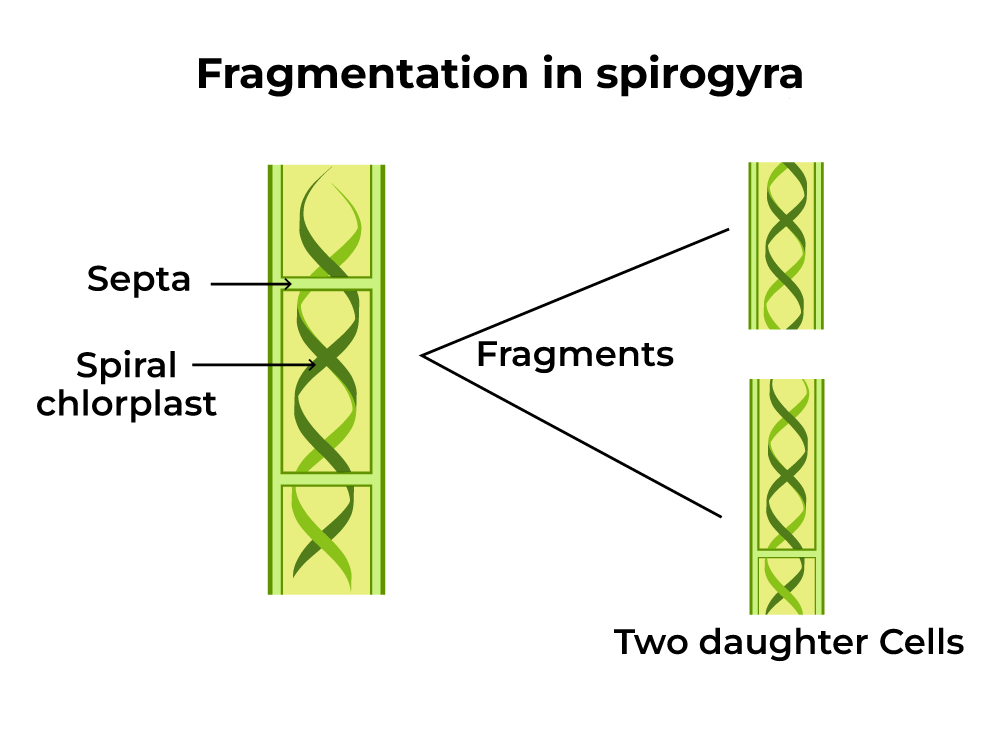
- Environmental Conditions- Favourable conditions such as the availability of water and nutrients are crucial for fragmentation in algae. The presence of these essential elements allows algae to grow and multiply efficiently.
- Breaking Up- When an alga reaches a certain growth stage, it naturally breaks into two or more fragments. This can be due to environmental factors or the internal biology of the algae.
- Development of Fragments- Each separated piece or fragment of the alga has the capacity to grow into a new individual. This development occurs when each fragment continues to grow and multiply in the presence of adequate nutrients and suitable conditions.
Outcome of Fragmentation-
- Rapid Multiplication- Due to fragmentation, algae can cover a large area in a relatively short time. This is due to the capacity of each fragment to grow into a new individual, thus increasing the population.
- Coverage- As each fragment develops into a new algal plant, they collectively lead to the formation of visible green patches in ponds or stagnant water bodies.
The Importance of Fragmentation in Algae-
- Efficiency- Fragmentation is an efficient way for algae to reproduce and spread in a conducive environment.
- Adaptability- It allows algae to adapt to and populate environments quickly where conditions allow for growth.
- Simplicity- This process is quite simple and doesn’t involve complex reproductive structures or processes, making it a straightforward mode of reproduction.
Spore Formation in Plants
What are Spores?
- Spores are asexual reproductive bodies produced by certain plants, including fungi, moss, and ferns.
- They are microscopic and can float in the air due to their light weight.
- Each spore is surrounded by a hard and resilient coat, enabling them to survive harsh environmental conditions such as high temperatures and low humidity.
The Process of Spore Formation
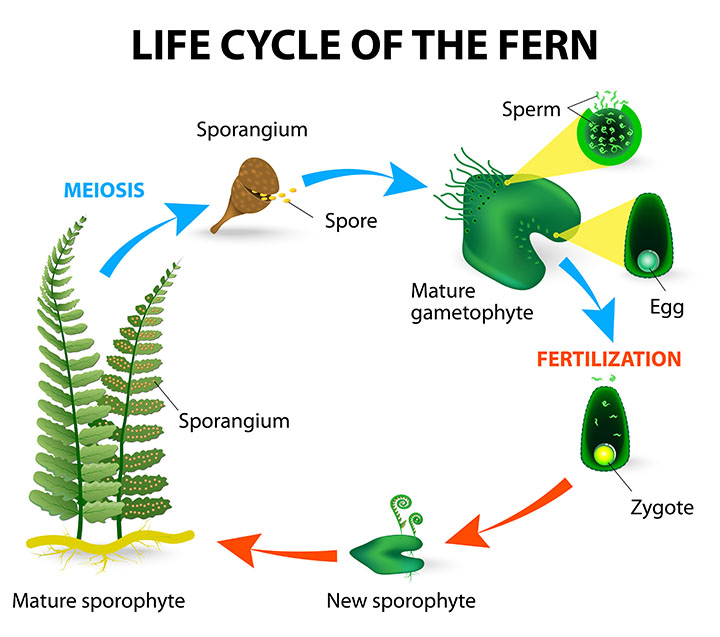
1. Spore Development and Release
- Spores develop in the sporangia of plants and fungi.
- When mature, spores are released into the air. Given their light weight, they can travel long distances, spreading the organism.
2. Survival in Unfavourable Conditions
- The hard protective coat of spores helps them to withstand adverse conditions, allowing them to remain dormant for extended periods.
- Spores can survive without water and nutrients, waiting for favourable conditions to germinate.
3. Germination of Spores
- Under suitable environmental conditions such as availability of water and nutrients, spores begin to germinate.
- They develop into new individuals, continuing the lifecycle of the organism.
Examples of Spore Formation
- Fungi-
- In fungi such as moulds, spores are produced in vast quantities.
- An example can be observed in bread mould, where spores in the surrounding air settle on the bread’s surface, germinate, and grow when conditions are right.
- Moss and Ferns-
- Moss and ferns also reproduce by means of spores.
- In these plants, sporangia (specialised structures) house and release spores.
The Importance of Spore Formation
- Adaptation to Environment- Spores are adapted to survive in varying environmental conditions due to their robust protective coats.
- Dispersal- Due to their lightweight nature, spores can disperse over wide areas, ensuring the spread of the organism.
- Resilience- Spores show remarkable resilience by remaining dormant in unfavourable conditions and germinating when the environment is conducive.
Sexual Reproduction in Plants
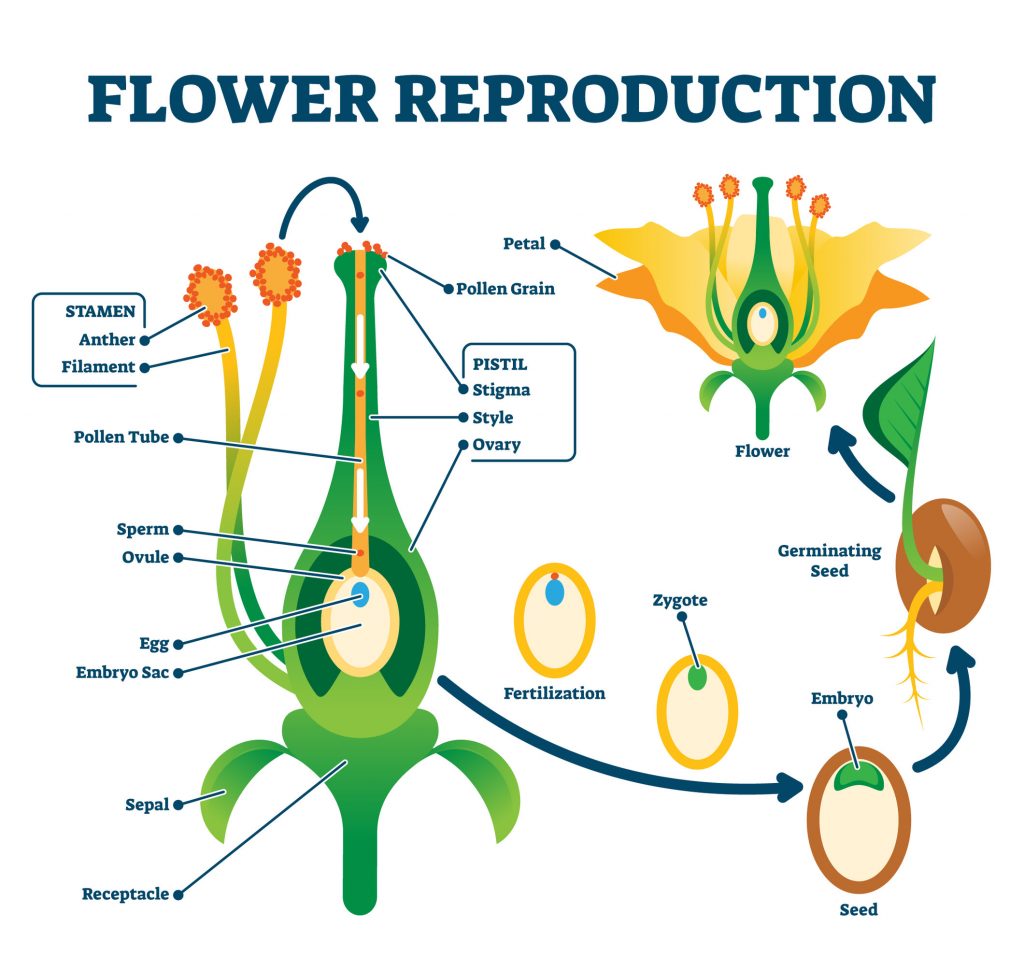
- Plants reproduce sexually through their flowers.
- Flowers are the reproductive parts of plants, containing male and/or female reproductive organs.
Parts of a Flower

Stamen (Male Reproductive Part)
The stamen is the male reproductive organ of a flower, fundamentally composed of two main parts-
Anther
- The anther is a critical component situated at the top of the stamen.
- It is involved in the production of pollen grains.
- Pollen grains are essentially the male gametes or sperm cells of a plant, which are vital for the process of fertilisation.
Filament
- The filament acts as a supportive structure, holding the anther in place.
- It is a slender, thread-like part, ensuring that the anther is positioned effectively to release pollen for pollination.
Pistil (Female Reproductive Part)
The pistil is the female reproductive organ situated at the centre of the flower, encompassing several key parts-
Stigma
- The stigma acts as the receptive surface for pollen grains.
- It plays a critical role during fertilisation by capturing and initiating the germination of pollen.
Style
- The style is a tube-like structure that connects the stigma to the ovary.
- It acts as a channel, allowing the pollen tubes to reach the ovary for fertilisation.
Ovary
- Located at the base of the pistil, the ovary is an essential component in the female reproductive system.
- Inside the ovary, one or more ovules are found where the female gametes, or eggs, are produced and housed.
- The ovary plays a crucial role in fertilisation and subsequent development into seeds and fruits.
Types of Flowers
Unisexual Flowers
- These flowers come equipped with either a stamen or a pistil, not both.
- Examples include corn, papaya, and cucumber.
- The specialisation allows for the separation of male and female reproductive functions, often leading to cross-pollination which increases genetic diversity.
Bisexual Flowers
- Bisexual flowers house both stamens and pistils within the same flower.
- Examples of plants bearing these flowers are mustard, rose, and petunia.
- Having both reproductive parts in one flower allows for self-pollination, although cross-pollination can also occur, ensuring fertilisation even in variable environmental conditions.
Pollination
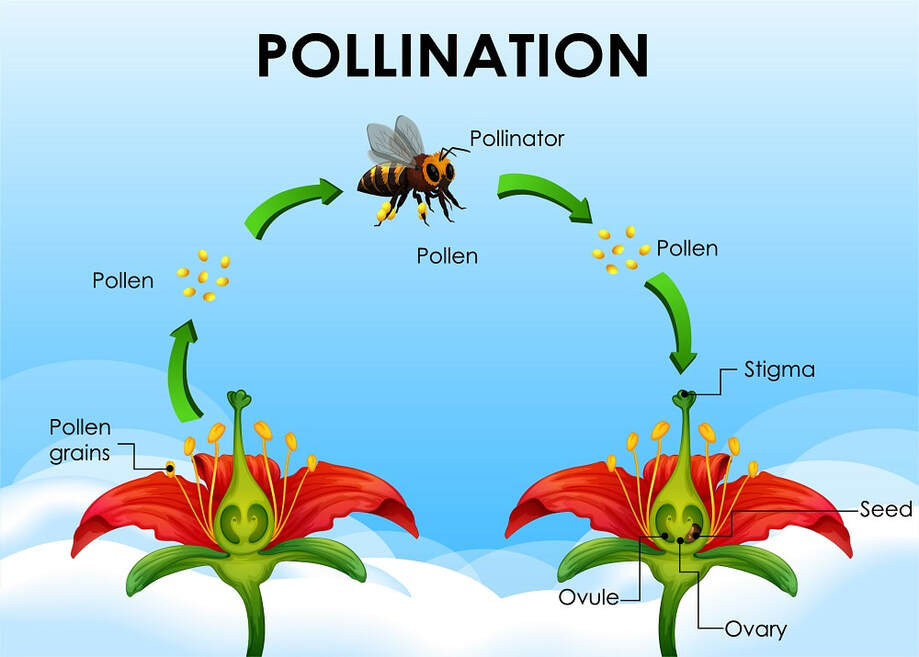
- Pollination is a fundamental process in the reproduction of most flowering plants. It involves the transfer of pollen grains from the male part of a flower (anther) to the female part (stigma) of the same or another flower.
Pollen Grains
- Pollen grains are microscopic particles that carry the male genetic material. They are encased in a tough protective layer, preventing them from drying up and facilitating their transfer between flowers.
Agents of Pollination
Wind-
- Plants that are pollinated by the wind usually have light, dry pollen that can be easily carried by air currents. These plants also tend to have feathery or large stigmas to catch the drifting pollen grains.
Water-
- Some plants use water as a medium to transport their pollen grains. Such plants release their pollen directly into the surrounding water, and it gets carried away by water currents to reach the stigma of other flowers.
Insects-
- Insect-pollinated flowers often produce nectar and have brightly coloured, fragrant flowers to attract insects. As insects such as bees, butterflies, and moths move from flower to flower to collect nectar or pollen, they inadvertently transfer pollen grains to the stigmas of the flowers they visit.
Types of Pollination
Self-Pollination
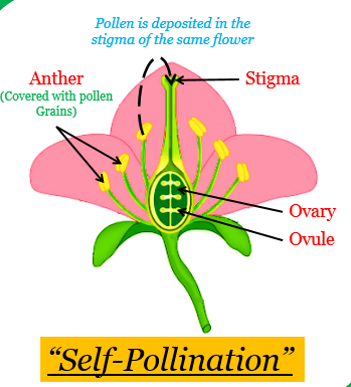
Occurs when pollen grains are transferred from the anther to the stigma of the same flower or another flower of the same plant.
This type of pollination doesn’t rely heavily on external agents and is more secure as it ensures that the pollen reaches the stigma of the same kind of flower.
Cross-Pollination

Takes place when pollen grains are transferred from the anther of a flower to the stigma of a flower on a different plant of the same species.
Cross-pollination promotes genetic diversity within plant populations, as it allows for the mixing of genetic materials from different individuals of the same species.
Significance of Pollination
Genetic Diversity-
- Cross-pollination helps in increasing genetic diversity within a plant population. Genetic diversity is crucial for the adaptability and survival of a species in changing environmental conditions.
Plant Survival and Evolution-
- Pollination ensures the continuation of plant species by facilitating reproduction. It also allows plants to evolve by mixing genetic materials, which might lead to the development of plants with better survival traits.
Fruit and Seed Formation-
- Pollination is a prerequisite for the formation of fruits and seeds in flowering plants. Successful pollination allows the plants to produce seeds that will grow into new plants, ensuring the survival of the species.
Ecosystem Diversity-
- Different agents of pollination contribute to the biodiversity of an ecosystem. For example, insects that act as pollinators are also part of the food chain, and their activities help in maintaining the balance of the ecosystem.
Fertilisation in Plants
Definition
Fertilisation in plants is the union of male and female gametes (sex cells), resulting in the formation of a zygote. This biological process is essential for sexual reproduction in plants.
Gamete Formation
- Male Gamete Formation- This occurs within the pollen grains that develop in the anther, a part of the stamen (the male reproductive organ in flowers).
- Female Gamete Formation- The egg cell, which is the female gamete, is formed within the ovule. The ovule is found in the ovary, which is a part of the pistil (the female reproductive organ in flowers).
The Process of Fertilisation
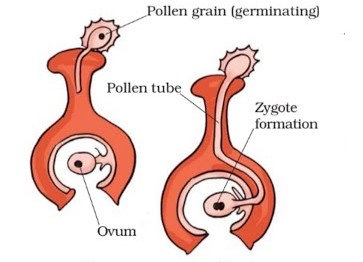
- Pollination– This is the transfer of pollen grains from an anther to the stigma of a flower. Pollination can be facilitated by various agents like wind, water, or pollinators such as bees and butterflies.
- Germination of Pollen- After a pollen grain reaches the stigma, it germinates, creating a pollen tube. This tube grows downward through the style towards the ovule.
- Fusion of Gametes- The male gamete travels through the pollen tube to reach the ovule. Here, it fuses with the female gamete (egg cell) to form a zygote.
Location of Fertilisation
The process of fertilisation occurs inside the ovule, which provides a secure environment for the delicate fusion of gametes.
Post-Fertilization Development
- Zygote Formation- The zygote is a single cell that is totipotent, meaning it has the potential to develop into a new organism.
- Embryo Formation- The zygote undergoes numerous cell divisions to become an embryo, which will eventually be enclosed within a seed.
Significance of Fertilisation
- Genetic Diversity- Fertilisation mixes genetic material from two different plants, leading to variation. This genetic diversity is crucial for the adaptability and evolution of plant species.
- Species Continuity- It is vital for the survival and propagation of plant species, as it leads to the generation of new plants.
- Initiation of Development- The zygote marks the beginning of a new life cycle, starting the process that will eventually result in a mature plant.
Observational Activities
- By dissecting flowers such as mustard, China rose, or petunia, one can study their reproductive parts. It helps in understanding the structure and function of stamens and pistils, as well as identifying whether a flower is unisexual or bisexual.
Fruits and Seed Formation
Fruits Formation- Detailed Explanation
Origin and Development
- From the Ovary- Fruits are a mature form of the ovary of a flower. After the process of fertilisation, where the male and female gametes fuse, the ovary undergoes transformations to develop into a fruit.
Characteristics and Types
- Protective Enclosure- Fruits serve as a protective enclosure for seeds. They house and safeguard the seeds, which are developed ovules.
- Variety in Nature-
- Fleshy Fruits- Such as mangoes and oranges, these fruits are characterised by their soft, juicy flesh. This succulence is a result of the transformation and ripening of the ovary.
- Hard Fruits- For example, almonds and walnuts, these fruits are encased in a tough, hard outer layer. They protect the seeds within effectively.
Process of Transformation
- Ripening- During this phase, the ovary, now a fruit, undergoes several changes. Nutrients accumulate within, and various biochemical changes occur, contributing to the colour, taste, and texture of the fruit.
- Seed Formation- As the fruit matures, the ovules within the ovary transform into seeds. Each seed contains an embryo that has the potential to germinate into a new plant under favourable conditions.
Relation to Seeds
- Enclosure for Seeds- The primary function of a fruit is to house and protect the seeds. The formation of fruits is directly linked to the process of seed formation, ensuring the continuation of the plant species.
Seed Formation
1. Initiation at Fertilisation-
- Seed formation begins after the process of fertilisation. The zygote formed after the fusion of male and female gametes undergoes multiple cell divisions to form an embryo, which is encased within the seed.
2. Development from Ovules-
- The ovules present within the ovary of a flower transform into seeds. Each ovule houses an embryo, which has developed from the fertilised zygote.
3. Seed Components-
- Embryo- The vital part of a seed, the embryo has the potential to grow into a new plant.
- Seed Coat- The embryo is enclosed in a protective layer known as the seed coat. It safeguards the embryo, preventing it from physical damage and desiccation.
4. Varieties of Seeds-
- Different plants produce seeds with various characteristics, influencing their dispersal and the environment suitable for their germination.
- Seeds can be encased within fleshy fruits, like in mangoes or oranges, or in hard shells, like in nuts such as almonds and walnuts.
5. Role in Plant Reproduction-
- Seeds play a crucial role in the continuation of plant species, acting as vehicles for the propagation of genetic material and the spread of plant populations across different areas.
6. Correlation with Fruits-
- The ripened ovary of a flower develops into a fruit, which houses the seeds. The nature of the fruit, whether fleshy or hard, influences the method of seed dispersal.
Seed Dispersal
Necessity of Seed Dispersal-
- Seed dispersal is vital for the survival and spread of plant species. If seeds were only to fall directly below the parent plant, they would face intense competition for resources such as sunlight, water, and minerals.
Avoidance of Competition-
- Dispersal allows seeds to be spread to different locations, minimising competition with the parent plant and among the siblings. It also helps the plants in invading new habitats for a more expansive distribution.
Methods of Seed Dispersal
- Wind- Some seeds are adapted to be carried by the wind. Seeds might be winged or lightweight, allowing the wind to carry them off to new locations.
- Water- Certain seeds have the ability to float and are carried away by water. They have spongy or fibrous outer coats, enabling them to be dispersed by water currents.
- Animals- Seeds, especially those with hooks or spines, get attached to the fur of animals, being transported to various places.
- Explosive Action- Some fruits burst open when they mature, causing the seeds to be ejected away from the parent plant.
Examples
- Wind- Drumstick and maple have winged seeds. Grasses have light seeds that can be easily blown away.
- Water- Coconuts have a fibrous outer coating that allows them to float on water.
- Animals- Seeds of plants like Xanthium and Urena have spines or hooks.
- Explosive Action- Seeds of plants like castor and balsam are dispersed by the sudden bursting of the fruit.
Significance
- Seed dispersal is essential for the survival of plant species. It ensures that plants can colonise new areas, maintain genetic diversity, and survive in different ecological niches.
Also Check – Class 7 – Science- Chapter 12 – Reproduction in Plants question answer (Long Question Answer)
Also Check – Class 7 – Science- Chapter 12 – Reproduction in Plants question answer (Short Question Answer)
Also Check – Chapter 12 – Reproduction in Plants–Class 7 science- Question and Answer (Solved MCQs)
Also Check – Chapter 12 – Reproduction in Plants-–Class 7 science- Question and Answer (Fill in the Blanks)
